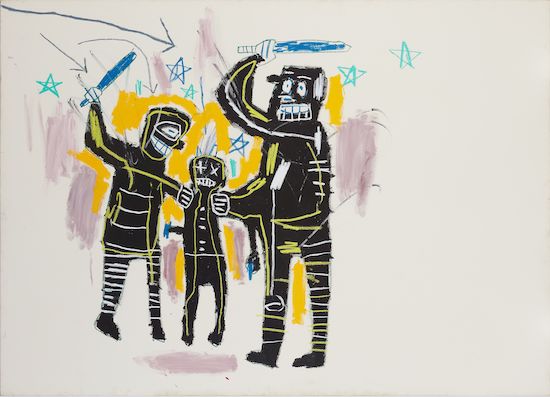Jawbone of an Ass, 1982 © The Estate of Jean-Michel Basquiat Licensed by Artestar, New York
When Jean-Michel Basquiat passed away, aged 27 in 1988, he left behind a father, a stepmother, two sisters, and a nephew. Basquiat is one of the most recognisable names in the art world today. Synonymous with the Downtown scene in 1980s New York, his short life and career has created a legacy that grows exponentially as time passes. But he was also a man, with a family, with passions and foibles. With this level of status, the person behind the work can get forgotten, condensed into a series of events and characteristics edited to fit the wider narrative and we know him as a prodigal talent, a maverick, a phenomenon and a flame that burned brightly and was extinguished too soon.
Basquiat’s father managed his estate up until his death in 2013 after which the artist’s sisters, Lisane and Jeanine took over. It was in 2020 following the death of George Floyd that they decided in earnest that they wanted to show a side of their brother they felt the world needed to see more of and shed light on where he came from. King Pleasure, installed in Chelsea, New York, and designed by David Adjaye OBE, seeks to shed light on his family and his childhood in Brooklyn. Highlighting the family’s role and the influence of Jean-Michel’s early life on the man he became, this extensive show includes many unseen paintings, workings and re-stages the artist’s studio and childhood home. For Basquiat’s sisters and stepmother this is a chance for people to learn about where he came from.
They put together a show including the music he loved, where he painted and the house he grew up in, a real picture that fills in the gaps between the boy, the man and his genius.
“We had some pretty clear intentions with this exhibition in really wanting to provide a more personal narrative and to put some context around Jean-Michel and his life and it seems like that is what people are receiving. So, we are happy about how things are going,” said Lisane Basquiat over Zoom.
What we know of Jean-Michel has been told to us mostly through his art dealers, his colleagues and his friends. Tales of a young man on the rise, graffiti, noise bands, sofa surfing and then stardom in the face of a sometimes hostile but in part facilitating US art world of parties, galleries and auctions.

Photograph Lee Jaffe
“What people heard before now is the perspective and stories coming from people that he may have shared a few months with, or friends that he hung out with, you know, in his early 20s. And whatever their perspectives are, good for them,” said Lisane. “But that was just that particular point in Jean-Michel’s life, it wasn’t his entirety. And I think that in the absence of our voice, people felt that’s all of who he was. What we’ve done with the show is really fill that in for them.”
Although Andy Warhol wrote in his diary that he was initially fascinated with Jean-Michel partly because he had, for a time, attended a fee-paying school in Brooklyn which was ‘kind of fancy’, the truth of Basquiat’s upbringing – middle class, educated and creative – doesn’t get much airtime. Lisane Basquiat and Jeanine Heriveax, Jean-Michel’s younger sisters wanted to add context to their brother’s story for any aspiring Basquiats out there and they have not only provided personal context but 200 little-seen works by the artist, plus notes, sketches and ephemera.
The show highlights what it was like to grow up in New York, in a creative environment surrounded by artists and musicians and be taken to the museums on your doorstep. While self-taught Jean-Michel spent a lot of time in museums growing up with his mother who would take him to the Brooklyn Museum, MoMA, The Botanical Gardens, Prospect Park, and that whole area of the city, their childhood was also filled with music which features heavily in the exhibition.

Jean-Michel Basquiat, Jailbirds, 1983. © The Estate of Jean-Michel Basquiat
“On our maternal side, we come from a family that loved music,” said Lisane. “So our grandfather and his buddies used to go down into the basement – and this is the Puerto Rican side of our family – they would go downstairs into the basement and jam out on the weekends and us kids would lay at the top of the stairs – because we weren’t allowed down there – so that we could peek our heads down and watch them banging it out, which was really a lot of fun,” she recalled, “the conga drums and the guitars and all of that.”
The sisters speak of their brother’s desire to engage with the city they grew up in, to participate in the creativity flourishing of New York in the 1970s which, despite being a dangerous place, was filled with venues, bars, and restaurants and fast becoming the centre of what would become the international art world. It was, at that time, relatively easy to make things happen. His early work, his graffiti as SAMO, came out of this as he interacted with the city, putting his mark on it and showing what he could do and taking his first steps towards finding his visual language.
Jeanine and Lisane wanted to show, through King Pleasure, their brother’s journey as a Black man in America at that time and how that translated to his work. His crown motif for example refers to having to raise yourself up and create your own royalty and recognise the greats from the Black community as they were not being recognised in the mainstream.

Jeanine & Lisane (credit: Miranda Penn Turin)
“All these things like royalty and the crown and what that means, what it meant to be a Black man, what it meant to be a man and what it meant to just be and to want people to see that he was an artist and to allow him to stand in that,” says Lisane of the crown motif her brother Jean-Michel used throughout his work.
Music plays through the exhibition spaces in recognition of Jean-Michel’s love of music and how much he loved to party. Alongside the exhibition the family have compiled a series of playlists inspired by the different sides of Jean-Michel’s musical life from the jazz and soul of his childhood to the pop and disco of his adulthood.
“We also included for you what Jean-Michel was listening to when he was working in his studio, he listened to a wide variety of music, a lot of jazz, some reggae, pop, some rock, and then of course, he partied in the mid-late 70s up to the mid 80s, so we included kind of that wide variety of music that he was listening to and was playing in the different clubs that he went to, as well,” said Jeanine of the process.

Jean-Michel Basquiat, Untitled (World Famous Vol. 1. Thesis), 1983. © The Estate of Jean-Michel Basquiat, Crayon on paper, 22 1_2 x 30 inches, Framed and glazed…
The exhibition seeks to immerse people in Jean-Michel the person because while he posthumously dominates the art market to this day, elements of his young life have been left almost mythic, confused and inaccurate. With this in mind, we can only wonder what it must be like, nearly 35 years after his death, to invite the public into a show about the boy behind the man who created such a legacy.
“This show has been cathartic and emotional with a lot of proud moments and a lot to reflect on; our childhood, our relationship with Jean-Michel … It has been a really, really heartfelt project,” Jeanine says, followed up by her sister Lisane, “It’s been incredibly cathartic. The process of grieving is such an interesting one, because there are different levels to it, so it was really healing in a lot of ways for me, and it’s been just a lot of fun.”
King Pleasure in on view at the Starrett-Lehigh Building, New York


